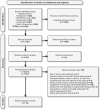Interventions on Barriers to the Participation of Adolescents in Physical Activity: A Systematic Review
- PMID: 40566312
- PMCID: PMC12193246
- DOI: 10.3390/ijerph22060881
Interventions on Barriers to the Participation of Adolescents in Physical Activity: A Systematic Review
Abstract
This review aimed to assess the effectiveness of interventions used to minimize barriers to participation in physical activity (PA) among adolescents. This systematic literature review followed the Preferred Reporting Items for Systematic Reviews and Meta-Analyses 2020 guidelines. Searches were conducted across five databases: PubMed, SPORTDiscus, Embase, Scopus, and Web of Science. Thirty-four studies evaluated interventions to overcome barriers to participation in PA, with a focus on lack of motivation, encouragement, and support, as well as intrapersonal, interpersonal, and environmental barriers. Most interventions were conducted in developed countries, with an emphasis on girls, reflecting efforts to address health inequities. The interventions, conducted in schools, included workshops, training programs, lectures, goal setting, and practical activities, lasting from four weeks to four years. Twenty-seven studies (79.4%) reported positive impacts on PA participation, particularly in interventions addressing psychosocial, psychological, and behavioral barriers. The most effective interventions combined theory (through educational approaches) and practice (practical PA activities). These findings contribute to understanding barriers leading to physical inactivity and provide insights for developing or replicating initiatives to improve PA levels among adolescents.
Keywords: adolescence; obstacles; participation in physical activity; physical inactivity; primary prevention.
Conflict of interest statement
The authors declare no conflicts of interest.
Figures



Similar articles
-
Barriers to physical activity in women from ethnic minority groups: a systematic review.BMC Womens Health. 2025 Jul 5;25(1):330. doi: 10.1186/s12905-025-03877-y. BMC Womens Health. 2025. PMID: 40618065 Free PMC article.
-
Participation in environmental enhancement and conservation activities for health and well-being in adults: a review of quantitative and qualitative evidence.Cochrane Database Syst Rev. 2016 May 21;2016(5):CD010351. doi: 10.1002/14651858.CD010351.pub2. Cochrane Database Syst Rev. 2016. PMID: 27207731 Free PMC article.
-
A systematic review of information and communication technology-based interventions for promoting physical activity behavior change in children and adolescents.J Med Internet Res. 2011 Jul 13;13(3):e48. doi: 10.2196/jmir.1533. J Med Internet Res. 2011. PMID: 21749967 Free PMC article.
-
Intervention Now to Eliminate Repeat Unintended Pregnancy in Teenagers (INTERUPT): a systematic review of intervention effectiveness and cost-effectiveness, and qualitative and realist synthesis of implementation factors and user engagement.Health Technol Assess. 2016 Feb;20(16):1-214. doi: 10.3310/hta20160. Health Technol Assess. 2016. PMID: 26931051 Free PMC article.
-
School-based physical activity programs for promoting physical activity and fitness in children and adolescents aged 6 to 18.Cochrane Database Syst Rev. 2021 Sep 23;9(9):CD007651. doi: 10.1002/14651858.CD007651.pub3. Cochrane Database Syst Rev. 2021. PMID: 34555181 Free PMC article.
References
-
- World Health Organization . Global Recommendations on Physical Activity for Health. WHO Press; Geneva, Switzerland: 2010. - PubMed
-
- Martinez R., Lloyd-Sherlock P., Soliz P., Ebrahim S., Vega E., Ordunez P., McKee M. Trends in premature avertable mortality from non-communicable diseases for 195 countries and territories, 1990–2017: A population-based study. Lancet Glob. Health. 2020;8:e511–e523. doi: 10.1016/S2214-109X(20)30035-8. - DOI - PubMed
-
- Botero J.P., Farah B.Q., Correia M.d.A., Lofrano-Prado M.C., Cucato G.G., Shumate G., Ritti-Dias R.M., Prado W.L.D. Impact of the COVID-19 pandemic stay at home order and social isolation on physical activity levels and sedentary behavior in Brazilian adults. Einstein (Sao Paulo) 2021;19:1–6. doi: 10.31744/einstein_journal/2021AE6156. - DOI - PMC - PubMed
-
- World Health Organization . Noncommunicable Diseases Progress Monitor 2020. WHO Press; Geneva, Switzerland: 2020.
Publication types
MeSH terms
LinkOut - more resources
Full Text Sources
Medical

